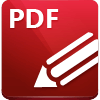 Stamp Tool
Stamp Tool
Click Stamp Tool to add stamps to documents:
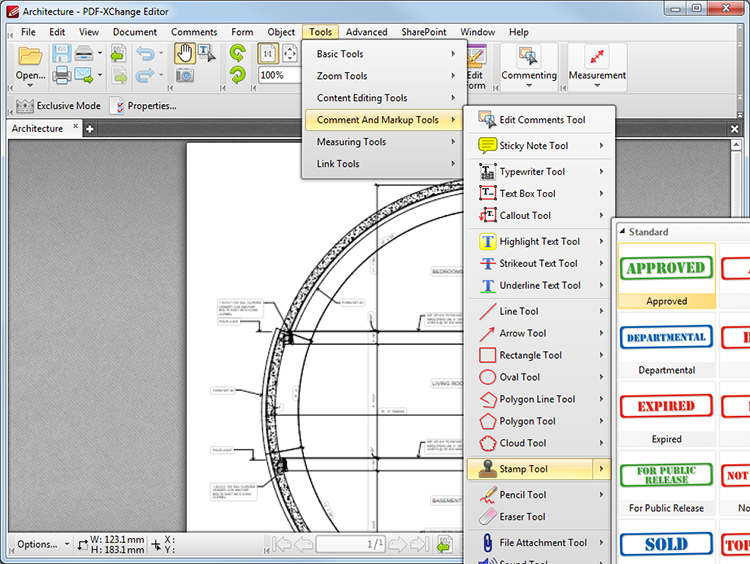
Figure 1. Tools Tab Submenu. Stamp Tool
When the Stamp Tool is selected, the active stamp will be displayed beneath the pointer. Move the pointer to the desired location and click to add stamps:
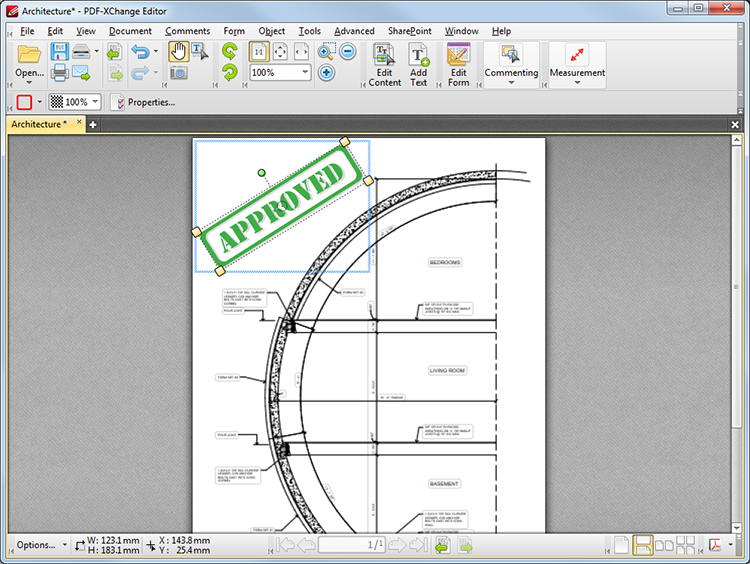
Figure 2. Sample Stamp
•Click and drag the yellow control points to resize stamps. Please note that stamp proportions are constrained.
•Click and drag stamps to reposition them.
•Click and drag the green control point to rotate stamps. Hold down Shift to rotate at increments of fifteen degrees.
•Use the arrow keys to reposition stamps.
•Use the editing aids detailed here to assist in the precise placement of stamps.
•Right-click stamps for further options. See here for an explanation of these options.
•When the Stamp Tool is selected, the following options are enabled in the Properties Toolbar:
•Stroke Color determines the color of pop-up notes associated with stamps. (The color of default stamps is fixed and can only be adjusted after stamps have been flattened. However, new stamps can be created as desired - see below).
•Opacity determines the level of transparency in stamps.
•Keep Selected determines whether or not the Stamp Tool remains selected after a stamp has been created. If this option is enabled then the tool will remain selected and can be used to create several stamps consecutively. If this option is not enabled then PDF-XChange Editor will revert to the designated default tool immediately after creating a stamp.
•Exclusive Mode simplifies the process of using the Stamp Tool. When Exclusive Mode is enabled, the pointer ignores all interactive elements of documents other than base content. This makes it possible to create stamps on areas that overlap with other content without the risk of accidentally selecting undesired items. When Exclusive Mode is disabled, the pointer recognizes and interacts with all underlying elements in the standard manner.
•Click Properties to view/edit the Stamp Tool Properties pane. See here for information on tool properties.
•The Commenting section of the Preferences dialog box can be used to view/edit preferences for comments.
Click the arrow beneath the Stamp icon in the Shortcut Toolbar to access the Stamps pane, which details all default and custom stamps:
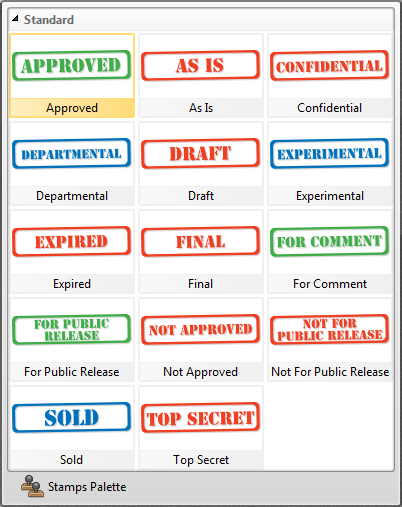
Figure 3. Stamps Pane
•Click to select stamps. They will then be displayed with the pointer. Click again to add stamps to the active document.
•Click Stamps Palette to open the Stamps Palette, which is a detached version of the Stamps pane. The following options are available:
•Use the Zoom In and Zoom Out icons to zoom in on/out from available stamps.
•Click New from File to create a new stamp. The Open Files dialog box will launch. Select a file from the local computer. The dialog box displayed in (figure 4) will launch.
•Click New From Clipboard to create a stamp from the image currently located on the clipboard of the local computer.
•Click Rename to rename the stamp currently selected. (This option is not available for default stamps).
•Click Delete to delete the stamp currently selected. (This option is not available for default stamps).
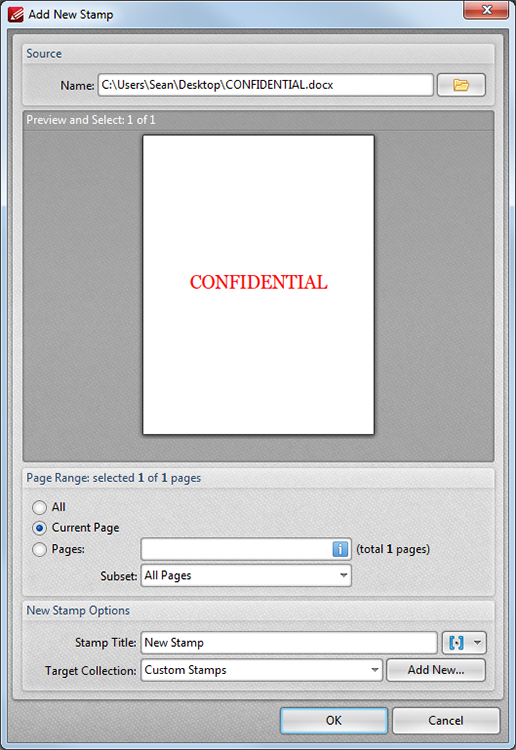
Figure 4. Add New Stamp Dialog Box
•Use the Source menu, or click the folder icon, to select a file to use as the stamp.
•The Pages Range options determine the pages of the file that will be used for the stamp:
•Select All to use all the pages of the file.
•Select Current Page to use only the current page.
•Select Pages to specify pages from the file. See here for further information.
•If more than one page is selected then a new stamp will be created for each page.
•Enter a name of the new stamp in the Stamp Title text box. Macros can be included in the stamp title.
•Use the Target Collection menu to determine the collection to which the new stamp will belong. Alternatively, click Add New to create a new collection.
•When the desired details have been selected, click OK to create the new stamp.
Please note the following when creating stamps:
•Images are usually in raster format and will pixellate if zoomed to a high degree. Therefore it is advisable to create stamps from pre-sized images. (Vector-based images do not experience this issue).
•If a transparent background is desired for stamps then a suitable image format must be used. The formats *.gif and *.png support transparency but *.jpg and *.pdf do not. N.b. Microsoft Paint does not handle *.png transparency well, but most modern graphics programs do. GIMP is one such program. A free GIMP download is available here.
•PDF files that contain transparent images/objects without backgrounds (such as scanned signatures) can also be used to create transparent stamps - empty space on the page will be ignored. Please note that content must be flattened before it can be used as a stamp. Right-click content and then click Flatten in order to flatten it.
If PDF-XChange Editor Plus has been purchased, then the additional features below are also available:
Add Dynamic Elements to Stamps
JavaScript can be included in stamps to add dynamic elements. Follow the steps below to achieve this:
1. Move to the Stamps Palette as detailed above.
2. Click New From File:
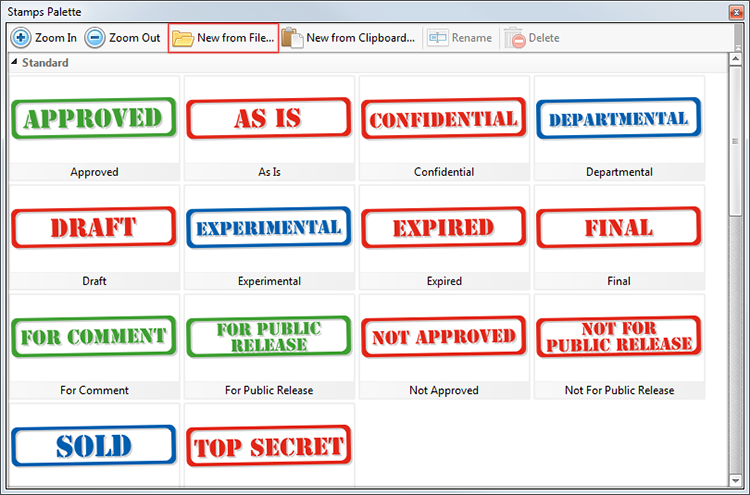
3. Select the file that will be used to create the stamp.
4. Follow the steps outlined beneath (figure 4) to create and save a new stamp.
5. Close PDF-XChange Editor Plus.
6. Move to the stamp within its destination folder on the local computer. Please note that the default folder is C:\Users\<User>\AppData\Roaming\Tracker Software\PDFXEditor\3.0\Stamps.
7. Move the stamp to the desktop. (This is a necessary step due to encoding parameters - if it is not included then changes cannot be saved).
8. Open the stamp with PDF-XChange Editor Plus.
9. Use the Form Toolbar to add a text field to the stamp.
10. Right-click the text field and click Properties. The Properties pane will open.
11. Under the Value Calculation property, use the menu to select Custom Action. The entry Calculate action / Run a JavaScript will appear at the bottom of the Properties pane:
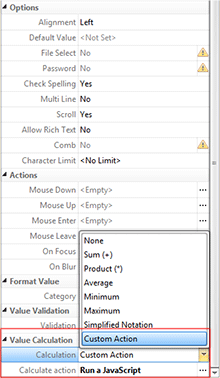
12. Click the ellipsis icon on the right of the Calculate action / Run a JavaScript property. The Edit Action: "Run a JavaScript" dialog box will open.
13. Enter the desired JavaScript and click OK.
14. Save the file and close PDF-XChange Editor Plus.
15. Return the stamp to its original destination folder. It will then be available in the specified stamp collection.
For example, entering the following JavaScript returns the user name/PC name at the time that associated stamps are created:
if((identity.name != null) && !/^\s*$/.test(identity.name))
event.value = identity.name;
else
event.value = identity.loginName.replace(/\./g," ").replace(/\./g,"
").replace(/\b(\w)/g,function(Word,cFst){return
cFst.toUpperCase()});
Please note that form content is evaluated immediately before stamps are placed and flattened immediately afterwards. The software will recognize it as a stamp, as opposed to a form field, despite the fact that it can include form field elements. The barcode and text field forms are compatible with this process. The other form fields do not retain their functionality.
Add Numbering to Stamps
Follow the steps below to add numbering to stamps:
1. Use the steps detailed above to create a dynamic stamp and enter the following JavaScript at step thirteen:
if (event.source.forReal && (event.source.stampName == "TCS9kAUOm4Abn56QZCOZE3"))
{
var counter = 0;
if (typeof event.source.source.info.stampCounter != undefined)
{
counter = event.source.source.info.stampCounter;
}
counter++;
event.source.source.info.stampCounter = counter;
event.value = counter;
}
else
{
event.value = 1;
}
2. Save the file and close PDF-XChange Editor Plus.
3. Return the stamp to its destination folder. (It should have been moved to the desktop at step seven of the process - see steps for adding dynamic elements to stamps, above).
4. Open PDF-XChange Editor Plus and create a new document.
5. Place the stamp in the new document and select it.
6. Press Ctrl+J. The JavaScript Console will open. Enter the following JavaScript:
this.selectedAnnots[0].AP
7. Click Run in the JavaScript Console.
8. An alphanumeric string will appear in the lower section of the JavaScript Console. Copy this string to the clipboard.
9. Close PDF-XChange Editor Plus.
10. Move the stamp from its destination folder to the desktop.
11. Open PDF-XChange Editor Plus and open the stamp.
12. Select Edit Form in the Form Toolbar and select the text field of the stamp.
13. Click Properties in the Edit tab.
14. Under the Value Calculation property, use the menu to select Custom Action. The entry Calculate action / Run a JavaScript will appear at the bottom of the Properties pane.
15. Click the ellipsis icon on the right of the Calculate action / Run a JavaScript property. The Edit Action: "Run a JavaScript" dialog box will open.
16. Replace the alphanumeric string on line one of the JavaScript Console with the alphanumeric string in the clipboard.
17. Save the file and close PDF-XChange Editor Plus.
18. Move the file from the desktop to its original folder. The stamp will then feature incremental numbering when it is placed in documents.
A complete list of JavaScript-supported actions is available here.